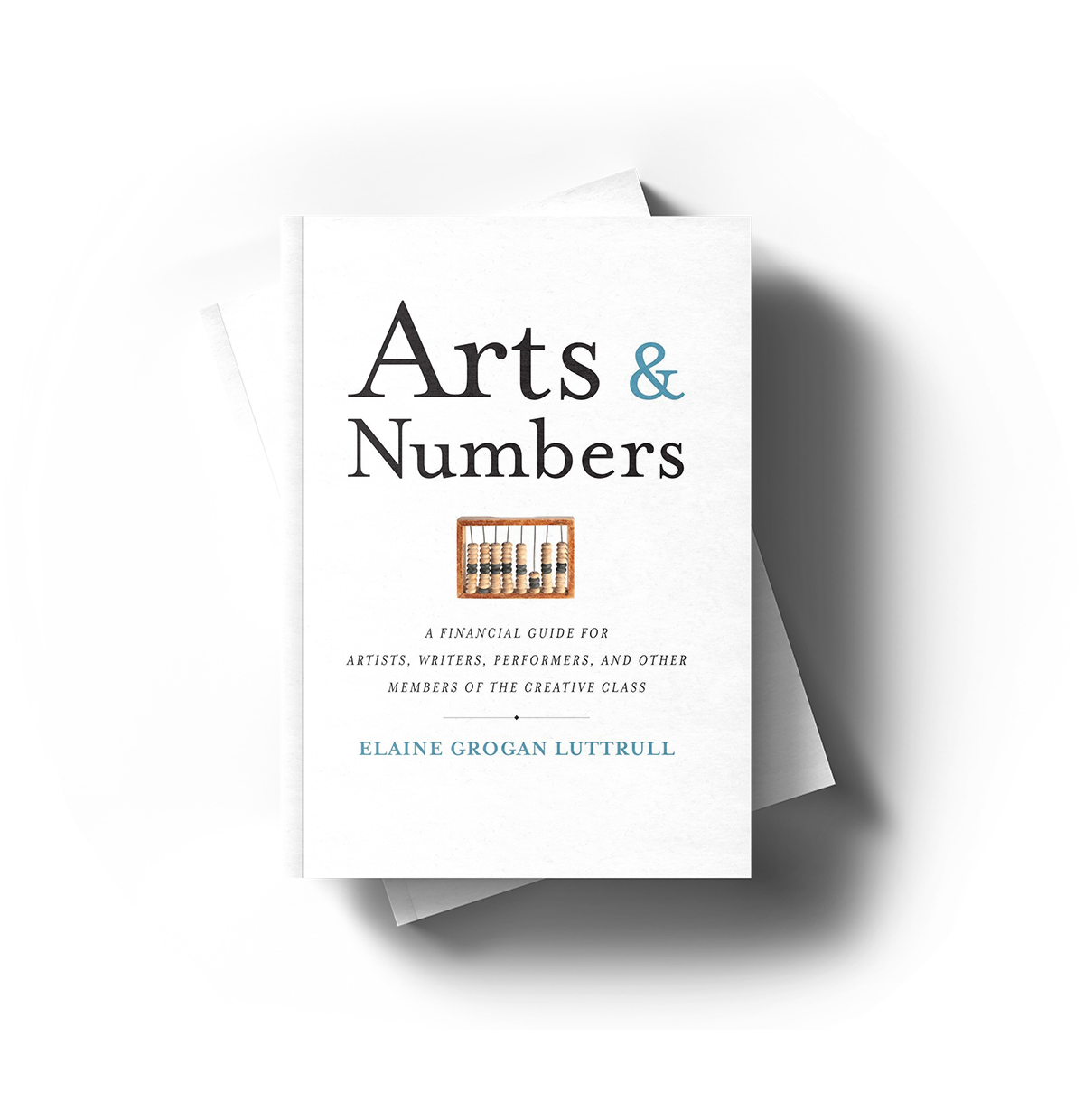March 14, 2016 • Events & Media
Originally written by Elaine Grogan Luttrull for the Clark Hulings Fund‘s striving artist series (“The Financial Secrets of Rich Kids“) and re-posted with permission.

“What are the rich kids doing that I’m not?”
I paused for a long time when I read that question. It was in response to a question I posed in advance of a Business of Art workshop I led last fall. “What would you most like to learn from this workshop?” I asked the participants.
“What are the rich kids doing that I’m not?”
The question implies there is some secret financial talk that wealthy people have. Or some secret class that wealthy people take. Or some secret book that “rich kids” read.
In reality, the basic premise behind acquiring and growing wealth is pretty simple. Spend less than you make, regardless of the number of zeroes in your income. That advice is true if your annual income is $25,000, $250,000 or $2,500,000.
Spend less than you make.
It isn’t complicated, but that doesn’t mean it is easy. Saving a smidge of each paycheck is much easier when the paychecks are predictable. It’s also easier when the paychecks involve an extra zero or two.
Artists often don’t have the luxury of predictability or additional zeroes.
In a recent story by Audrey Quinn, which aired on Planet Money on NPR in February, she highlighted this idea. The story was called “Why Work from Home Scams Persist” and about three and a half minutes into the piece, a quote caught my attention. “When you’re someone who’s never done so great financially, it can seem kind of like magic how other people make lots of money.” Quinn was summarizing a perspective from Christine Durst, but I’ve heard the sentiment expressed from plenty of artists.
“What are all the rich kids doing that I’m not?”
It does feel like magic. It does feel like a secret we aren’t necessarily privy to. The challenge inherent in accomplishing something that seems so simple—spend less than you make—can bathe the idea in a magical light.
And beyond the apparent magic, there are some simple (and relatively easy) steps we can take to adopt the basic “rich kid” premise.
Avoid Hidden “Taxes”
The easiest way to spend less than you make is to eliminate totally unnecessary spending, for example the hidden “taxes” we pay without even realizing it.
Our “sin taxes” fall into this category. These are the taxes imposed by state and local governments on certain items, but not others, generally to support public health initiatives. The “soda tax” in New York falls into this category, as do most taxes on cigarettes.
The “pink tax” is the higher cost female users pay for products relative to “male” versions of the same product. Janet Floyd famously embarked on a crusade in New York to figure out why laundering women’s shirts cost so much more than laundering men’s shirts. She found that on average, women pay $2.09 more than men to launder button down shirts. (Floyd surveyed 50 dry cleaners and the average price to launder a man’s shirt was $2.86; the female equivalent was $4.95.)
Regularly, we’re told (if we’re told) that the laundering and pressing equipment is built to accommodate male, but not female, garments.
Consumer Reports found in January of 2010 that this “pink tax” extended to common drugstore products as well, including shaving cream, antiperspirant, pain relievers, razor blades, and more. This tax may be subtly incorporated into all sorts of products, and the tax is easy to avoid by purchasing unisex or “male” versions of these products. Especially if you have a clear idea of what you need.
Most of us have no idea we pay a pink tax or any other hidden tax. What other taxes might we pay without having any idea we are paying them?
What about a “waste tax” in the cost of supplies and other goods we throw away without fully using them? Or a “spoil tax” when we throw away food that has gone bad before we consume it? Or a “leftover tax” on unconsumed leftovers we throw away? Or a “volume tax” when we accidentally pay more per ounce of whatever we consume because we unwittingly purchase the “value” box without looking closely to see if it actually provided us with any financial value?
What about a “negotiation tax” when we unwittingly pay a higher-than-required price for something because we failed to ask if there was a discount or a less expensive option? Plenty of businesses we frequent, from our financial institutions to our suppliers to our dry cleaners, grocers, and travel partners, have considerable flexibility in imposing—or not imposing fees.
Think of how much we’d save by eliminating these payments we make unwittingly—these hidden “taxes” we pay that deliver no additional value.
Make Empowered Decisions
It is certainly an empowered financial decision to eliminate hidden taxes from your monthly spending. But the empowerment isn’t limited to the spending side. Remember, the advice is to “spend less than you make.” What you make is part of the equation as well.
We can choose to earn money deliberately. The ways we earn money don’t always align perfectly with our passions. In a perfect world, we’d earn outrageous amounts of money by doing work we absolutely love without hesitation. In our delightfully imperfect world, we may choose to earn money from our skills even if those skills aren’t perfectly aligned with our passion projects.
Consider an illustrator whose passion projects include witty, brilliant editorial cartoons. He may also illustrate anatomy textbooks on the side because the money is good. He’s creating value from his skills, even if they don’t perfectly align with his passions.
A web designer may be passionate about helping companies articulate their missions creatively through effective logo design. And she may also design and update letterhead, power point templates, and word document templates for a bit of extra cash.
A sculptor who creates commissioned installations may occasionally teach workshops for kids as an additional source of income. She may derive creative fulfillment from both endeavors, but only one may be her true passion.
We may choose to make empowered decisions about how we spend our time and how we earn our money. We may choose to make informed, deliberate decisions with very specific end results in mind (a growing emergency reserve fund, for example). Those choices empower us financially and liberate us creatively.
Making empowered financial decisions about how we want to earn our money is just as important as making empowered financial decisions about how we want to spend our money.
And both lead us to spending less than we make.
Watch It Grow
The real magic in the “spend less than you make” advice is in the rapid accumulation of the “less.” It really is amazing how just a bit here and there adds up, whether through making empowered financial decisions about earnings (to increase the “making” part of the rule), deliberate financial choices about deploying limited resources (to reduce the “spending” part of the rule), and strategic shopping decisions to avoid hidden taxes. Most of these savings came from mindfulness and making empowered financial decisions (see above), and most of them didn’t feel big.
Small savings add up in big ways over time. “Time” is the key part of that equation though. And time in this case is nothing more than sacrifice and patience.
Plenty of financial institutions encourage savings through round-up apps and sweep accounts that transfer extra bits from each transaction into a unique savings account. Some institutions even match the amount you save as an extra incentive to save even more (although these tend to be short-lived promotions). Saving in a separate account (a free one—no hidden taxes here!) puts your savings out of mind, if you will, so you won’t necessarily be tempted to spend it on your regular living expenses. (This idea is in part why 401(k)s or IRAs help us save for retirement so effectively. We take the savings out early and separate it from our “normal” spending.) The accumulation will happen slowly at first, then a bit faster as the savings compound with a small amount of interest.
If you’d prefer a more physical approach, add a jar somewhere in your studio, your office, or your home to collect spare change every day. Empty your pockets or your pocket book or your backpack and put the change in the jar on a regular basis.
The trick is to keep it slightly out of mind, though. Just as saving in a separate bank account trains our brains to think of our spendable income as only what we see in a savings account, using an opaque container to collect coins keeps the volume of coins inside the vessel a surprise. You’ll be pleasantly surprised when you find the jar full, and you’ll be even more pleasantly surprised when you convert the coins into cash. (Be careful not to pay a hidden tax as part of this process though. Use your own financial institution’s counting machine to convert the coins to cash and avoid paying a fee on the process.)
As this amount slowly adds up, the real magic of “spend less than you make” becomes apparent and we suddenly have an emergency reserve fund. I always called mine an “I quit fund” so I could leave a job for any reason at any time. More colorful commentators have added an expletive to the title of this fund.
But maybe we should start calling it a Rich Kid Fund. Because we can all be the “rich kids” with a bit of savings and the financial empowerment that comes with it.
In some families, this lesson is incorporated into dinner table conversation or daily spending habits or behavior-modeling that subtly empowers the financial decisions we make as adults.
For those who might have had slightly different childhood experiences with money, this idea can feel magical. It can feel like a secret.
But now, thank goodness, the secret is out.


